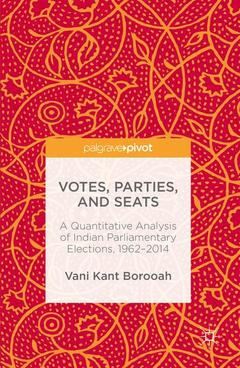Votes, Parties, and Seats, Softcover reprint of the original 1st ed. 2016 A Quantitative Analysis of Indian Parliamentary Elections, 1962-2014
Auteur : Borooah Vani Kant

Presents a rigorous examination of data from every Lok Sabha general election between 1962 and 2014
Reviews the election result for each candidate and for all constituencies
Discusses the relationship between a party's votes and its seats in India's First Past the Post electoral system
Date de parution : 06-2016
Ouvrage de 160 p.
14.8x21 cm
Disponible chez l'éditeur (délai d'approvisionnement : 15 jours).
Prix indicatif 58,01 €
Ajouter au panierDate de parution : 06-2018
Ouvrage de 160 p.
14.8x21 cm



